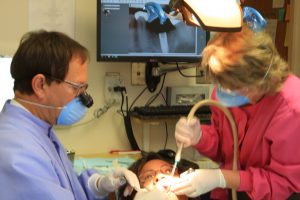Header logo
header top contact widget
Periodontal (Gum) Disease
Smokers Add Challenges To Dental Implant Success
Posted on Aug 09, 2016 by William J. Claiborne, DDS MS
Not only does smoking complicate the body’s natural ability to heal, it is a particular challenge to oral tissues. The chemicals in cigarette smoke have a drying effect on the gum and decreases blood oxygen levels. This results in slower healing and can lead to a greater risk of bacterial build-up.
In implant placement, both gum tissue and bone are involved in the process. Through gum tissues, I position each implant in the upper or lower jaw bone at a precise depth and angle.
Once the implant is placed, it requires a healing period as the bone grows around it, securing it in place. This process is known as ‘osseo-integration.’ Proper healing requires normal blood circulation and sufficient oxygen levels. Implant failures occur most often during this phase when the bone is growing around the implant.
In addition to smoking’s effects on the rate of tissue and bone recovery, smoking patients can develop a condition known as peri–implantitis. Peri-implantitis leads to inflammation around the implant site and pockets of pus that form in gum tissues. Although the potential to develop peri–implantitis exists for any dental implant patient, smokers have a substantially higher risk.
When smokers develop infections after implant surgery, medications used to combat the infection have a reduced effect. This is because the potency of antibiotics does not work as well on smokers. When infection is not eliminated before it can work its way into the implant area, the risk for losing the implant is significant.
Keep in mind that an implant that must be removed due to the healing complications of smoking is not refundable. This means that the investment you made has gone up in smoke – cigarette smoke.
So many negative effects from smoking make it highly advisable to stop smoking prior to implant placement. If you don’t stop, you can increase your potential for success somewhat by reducing your smoking by half at least one week prior to your placement procedure and throughout the healing period.
Having dental implants allows you to eat the foods you love again and restores eating comfort and smiling confidence. The many benefits you’ll reap with dental implants are well worth kicking the habit. Call 828-274-9440 to schedule a consultation to discuss your potential for a successful outcome.
The Road To Gum Disease
Posted on Aug 03, 2016 by William J. Claiborne, DDS MS
People are often surprised to hear that they have developed periodontal (gum) disease. And no wonder. When gum disease first begins, it’s often without obvious symptoms. Then, once it’s fully underway, the warning signs are often ignored.
Yet, the road that leads to gum disease is shorter than you might imagine. Below is the typical process of how gum disease begins and progresses:
• Oral Bacteria: We all have bacteria in our mouths. This warm, moist environment takes in an enormous amount of bacteria-laden items. Bacteria is on our food, utensils, the glass we drink from and the pencil we hold between our teeth. Of course, bacteria cannot be prevented altogether. However, the problem begins when too much bacteria accumulate.
• Plaque: Without proper brushing, flossing, saliva flow and diet, oral bacteria can reproduce rapidly. Their accumulation over the course of a day forms a sticky film you feel on teeth. This is known as plaque.
• Tartar (or Calculus): In just 48 hours, unremoved plaque can harden into tartar. This is actually a cement-hard colony of oral bacteria that attaches to teeth. And, like plaque, tartar will continually reproduce and grow as the bacteria feed on tooth enamel and tender gum tissues.
• Gingivitis: This is actually the first stage of gum disease. At this level, gum tissues are under attack and become sore. They may bleed easily when brushing and you may experience an aching sensation in some areas. Your breath will no longer feel fresh. At this point, with proper measures, you can restore your gums to a healthy state. However, there is a fine line between being able to undo gingivitis and its progression to gum disease.
• Gum Disease: At this level, the gums are inflamed and tender. You may notice them darken in color and begin to pull away from the base of some teeth. You’ll have persistent bad breath. As it progresses, pus pockets will form in some areas. Without thorough treatment, teeth will loosen and may eventually require removal.
Nearly half of American adults have some level of gum disease. Sadly, it is the nation’s leading cause of adult tooth loss. Yet, it’s one of the most preventable diseases with simple measures.
Twice daily brushing (at least two minutes per time), daily flossing, drinking ample water and limiting sweets and caffeine are simple ways to keep your mouth healthy between regular dental check-ups and cleanings. And, those 6-month check-ups are important. At this time, any tartar that has accumulated can be removed and signs of early gum disease can be noted. 
Imagine losing your teeth and having to decide on a crown-&-bridge combination, partial, full denture or Dental Implants. These procedures can be avoided. And, contrary to what many believe, losing teeth is not a natural part of the aging process. With proper care, you can easily enjoy a smile of natural teeth all your life.
If you are experiencing symptoms of gum disease, call 828-274-9440. We’ll restore your smile and develop a program to help you keep it at its best.
Diabetes Related To Your Oral Health?
Posted on Jul 19, 2016 by William J. Claiborne, DDS MS
The World Health Organization (WHO) has declared diabetes to be at a pandemic level with a prevalence that has risen dramatically over recent decades. And, the number of those affected by diabetes is expected to triple in the next decade.
Diabetes is a leading cause of death due to the vascular complications it causes. The most common types of diabetes are type 1, which requires insulin control, and type 2, which is non-insulin dependent.
Diabetes is a metabolic disease that results from insufficient insulin secretion or being resistant to insulin. This occurs when the body is unable to properly process carbohydrates, fats and proteins.
Regardless of the advancements in treating diabetes, the U.S. National Library of Medicine & National Institutes of Health reports that it is “a growing public health concern and a common chronic metabolic disease worldwide.”
Diabetes affects all age groups but is most common in adults. According to the American Diabetes Association, the largest segment of those who suffer with diabetics have Type 2 diabetes, which usually begins after age 45.
Initial warning signs of Type 2 diabetes are bad breath and bleeding gums, which are also symptoms of gum disease. Gum disease has been found to be more frequent and severe for patients who have poor control of their diabetes. It has been shown that diabetics can help to prevent periodontal disease by properly controlling glucose levels. This is also helpful in the successful treatment of periodontal disease.
To those in the medical and scientific fields, the initial emergence of diabetes in the form of oral problems makes perfect sense. For decades, various inflammatory diseases and periodontal (gum) disease have shown connections. Not only is gum disease the sixth greatest complication of diabetes, research has shown that one triggers the other.
Periodontal disease is an inflammatory condition that can create inflammatory reactions elsewhere in the body. Because of this relationship, diabetics are advised to have frequent dental exams (every 3-4 months) to avoid the inflammatory reactions of gum disease, and vice versa.
Symptoms of periodontal disease include gum tenderness, bleeding gums when brushing, frequent bad breath, gum recession and gums that darken in color. When these signs are present, an individual should arrange to be promptly seen by a Periodontal specialist before gum disease worsens. For diabetics, the need for treatment has even greater urgency since they have a particular vulnerability to inflammatory reactions in the body.
After a periodontal examination, we will discuss treatment recommendations if gum disease does exist. Call 828-274-9440 to arrange an appointment. And remember, gum disease only worsens without treatment, resulting in greater treatment time and expense with delays. It is also the nation’s leading cause of adult tooth loss.
You Can Help Your Dental Implant’s Success
Posted on Jul 14, 2016 by William J. Claiborne, DDS MS
Over the years, the design and placement process of Dental Implants have been so perfected that they’ve come to hold one of the highest success rates of all in-bone implant types – nearly 97%.
One of the reasons that Dental Implants are such a wise investment is that they are designed to last your lifetime. However, there is a potential for failure. Like any procedure that involves an implant in human bone (including hip, knee, etc.), there is an element of risk.
Having an implant removed due to infection or malfunction is difficult for the patient. Although it’s not a frequent occurrence, removing an implant means the patient has lost their investment and must endure additional procedures and expenses for repair and replacement. How can you help to minimize this risk?
One of the most important factors in any successful medical or dental procedure begins with the doctor who coordinates your care. Your doctor should never be selected based on the lowest fee. The doctor chosen should have extensive training and experience in the diagnosis and placement of all types of Dental Implant systems. This enables him or her to select an implant that is appropriate for your individual needs.
In selecting the doctor who will oversee your treatment, you should also look for advanced skills in the placement of your implants. Successful placement relies on the ability to assess for adequate bone mass to support an implant without interfering with adjacent structures. The ability to select the proper implant type for available bone depth is equally important.
Without proper placement in sufficient bone, an implant risks coming in contact with a nerve that extends horizontally through the lower jaw. Upper implants placed too close to the sinus cavity can, over time, penetrate that area. Removing an implant in either of these situations, of course, is no simple task.
Obviously, a qualified doctor can enhance your potential for a successful outcome. This is why many people rely on a periodontal specialist. A Periodontist has particular expertise in the diagnosis and placement of all types of Dental Implants. As a matter of fact, many general dentists prefer to have a Periodontist place implants in their patients. The patient then returns to their dentist for the attachment of teeth to the implants.
While the doctor involved in your treatment is important, much of the risk falls into the patient’s hands after the placement process.
As a patient, helping to have a successful outcome begins as soon as your implants are placed. First, closely follow your post-placement instructions. For a few days following placement, most patients are advised to eat only cool, soft foods. This helps to minimize swelling and bleeding, which helps gum tissues to more quickly seal incision sites. This can lower your risk for infection.
Once home, other factors can also place your implants at risk. For example, smokers have a higher risk for implant failure. Because the chemicals in cigarette smoke are very drying to oral tissues, the healing process takes longer. Delayed healing creates a greater risk for infection to occur.
An element of risk that may surprise you is grinding or clenching teeth during sleep, which is typically a symptom of a misaligned bite. Some clenching is so intense the force can be likened to that used to crack a walnut. A sign of night-time clenching or grinding may be worn, chipped or broken teeth. However, even without signs, if you suspect you grind or clench, mention this to your implant dentist prior to treatment. This way, proactive measures can be taken to resolve the problem before complications result.
Most important of all is the patient’s commitment to maintaining good oral hygiene. Although Dental Implants themselves do not experience decay, the gum tissues and bone supporting the implants are as susceptible to oral bacteria as before. When oral bacteria infection (gum disease) penetrates to the implant site positions, the only way to treat the infection may require removing the implant.
Having Dental Implants will require you to be highly committed to your oral hygiene at home. Additionally, your dental check-ups will likely be scheduled for every four months than twice a year. During these visits, a hygienist will remove accumulated oral bacteria to reduce risk to your Dental Implants. The condition of your gums will also be assessed.
At Biltmore Periodontics, we are very proud of our success rate. When our patients regain the ability to bite, chew and laugh with confidence, we celebrate right along with them. Our goal, for every patient, is to have each enjoy confident smiles for a lifetime!
If you’ve considered Dental Implants, let’s discuss the types that may be best for you. Call 828-274-9440 to schedule a consultation appointment. I’ll explain the process and answer your questions thoroughly.
Recent Posts
Categories
Archives
- September 2024
- August 2024
- July 2024
- June 2024
- May 2024
- April 2024
- March 2024
- February 2024
- January 2024
- December 2023
- November 2023
- October 2023
- September 2023
- August 2023
- July 2023
- June 2023
- May 2023
- April 2023
- March 2023
- February 2023
- January 2023
- December 2022
- November 2022
- October 2022
- September 2022
- August 2022
- July 2022
- June 2022
- May 2022
- April 2022
- March 2022
- February 2022
- January 2022
- December 2021
- November 2021
- October 2021
- September 2021
- August 2021
- July 2021
- June 2021
- May 2021
- April 2021
- March 2021
- February 2021
- January 2021
- December 2020
- November 2020
- October 2020
- September 2020
- August 2020
- July 2020
- June 2020
- May 2020
- April 2020
- March 2020
- February 2020
- January 2020
- December 2019
- November 2019
- October 2019
- September 2019
- August 2019
- July 2019
- June 2019
- May 2019
- April 2019
- March 2019
- February 2019
- January 2019
- December 2018
- November 2018
- October 2018
- September 2018
- August 2018
- July 2018
- June 2018
- May 2018
- April 2018
- March 2018
- February 2018
- January 2018
- December 2017
- November 2017
- October 2017
- September 2017
- August 2017
- July 2017
- June 2017
- May 2017
- April 2017
- March 2017
- February 2017
- January 2017
- December 2016
- November 2016
- October 2016
- September 2016
- August 2016
- July 2016
- June 2016
- May 2016
- April 2016
- March 2016
- February 2016
- January 2016
- December 2015
- November 2015
- October 2015
- September 2015
- August 2015
- July 2015
- June 2015
- May 2015
- April 2015
- March 2015
- February 2015
- January 2015
- December 2014
- November 2014
- October 2014
- September 2014
- August 2014
- July 2014
- June 2014
- May 2014
- April 2014
- March 2014
- February 2014
- January 2014
- December 2013
- November 2013
- October 2013
- September 2013
- August 2013
- July 2013
- June 2013
- May 2013
- April 2013
- March 2013
- February 2013
- January 2013
- December 2012
- November 2012
- October 2012
- September 2012
- August 2012
- July 2012
- June 2012


